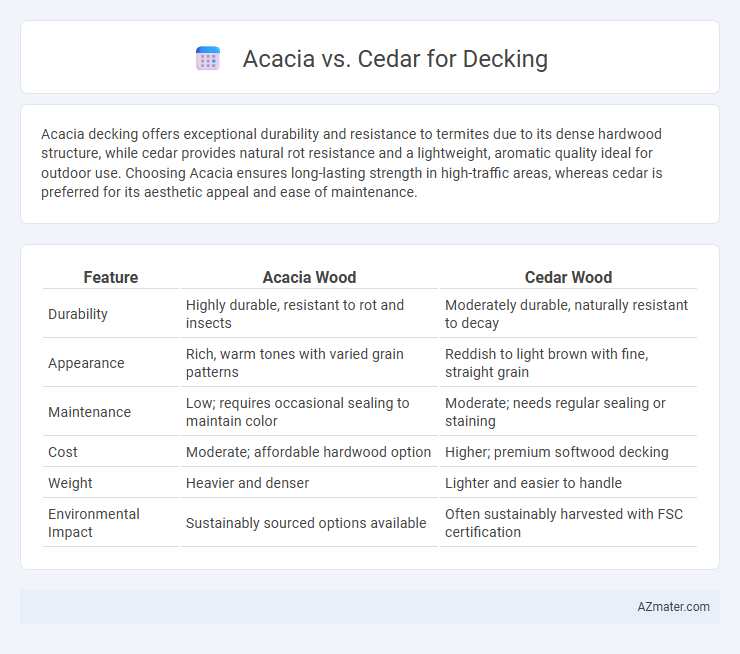Acacia decking offers exceptional durability and resistance to termites due to its dense hardwood structure, while cedar provides natural rot resistance and a lightweight, aromatic quality ideal for outdoor use. Choosing Acacia ensures long-lasting strength in high-traffic areas, whereas cedar is preferred for its aesthetic appeal and ease of maintenance.
Table of Comparison
| Feature | Acacia Wood | Cedar Wood |
|---|---|---|
| Durability | Highly durable, resistant to rot and insects | Moderately durable, naturally resistant to decay |
| Appearance | Rich, warm tones with varied grain patterns | Reddish to light brown with fine, straight grain |
| Maintenance | Low; requires occasional sealing to maintain color | Moderate; needs regular sealing or staining |
| Cost | Moderate; affordable hardwood option | Higher; premium softwood decking |
| Weight | Heavier and denser | Lighter and easier to handle |
| Environmental Impact | Sustainably sourced options available | Often sustainably harvested with FSC certification |
Introduction: Acacia vs Cedar Decking
Acacia and cedar are two popular wood choices for decking due to their durability and natural beauty. Acacia offers a dense, hardwood option with rich amber tones and high resistance to weather and insects. Cedar provides a softer texture with natural oils that protect against rot and decay, making it a lightweight and aromatic choice for outdoor decks.
Wood Characteristics: Acacia and Cedar
Acacia wood is dense, durable, and highly resistant to wear and water damage, making it ideal for long-lasting decking that withstands heavy foot traffic and outdoor elements. Cedar wood is lighter, naturally resistant to rot and insects, and offers excellent dimensional stability, reducing warping and cracking over time in varied weather conditions. Both woods provide unique textures and rich hues, with Acacia featuring a deep reddish-brown tone and Cedar showcasing a warm, aromatic, and pale reddish color perfect for aesthetic outdoor decking projects.
Durability and Longevity Comparison
Acacia decking offers excellent durability with natural resistance to rot, insects, and weather, making it suitable for outdoor use in various climates. Cedar, known for its natural oils, provides strong resistance to decay and insect damage but may require more regular maintenance to maintain longevity. Both woods can last up to 20-30 years with proper care, though acacia's denser grain typically offers enhanced hardness and longer-lasting performance under heavy traffic conditions.
Weather Resistance and Maintenance Needs
Acacia wood offers strong weather resistance due to its natural oils, making it highly durable against moisture and pests, thus requiring less frequent sealing and maintenance. Cedar is also naturally weather-resistant with excellent dimensional stability and resistance to rot and insects, but it generally demands regular treatments and sealing to maintain its appearance and longevity. Both woods provide good durability, but Acacia typically requires lower ongoing maintenance compared to Cedar in harsh weather conditions.
Aesthetic Appeal and Grain Patterns
Acacia decking showcases rich, warm hues with vibrant amber to reddish tones, featuring swirling grain patterns that add a dynamic and exotic look to outdoor spaces. Cedar decking offers a more uniform, fine-grained texture with soft reddish-brown coloration that weathers to a silver-gray patina over time, providing a classic and rustic charm. The contrasting grain patterns--Acacia's bold, varied streaks versus Cedar's subtle, straight lines--make each wood distinct, catering to different aesthetic preferences for decking projects.
Cost Analysis: Acacia vs Cedar
Acacia decking generally offers a more cost-effective option compared to cedar, with prices typically 20-30% lower due to its faster growth and abundance. Cedar decking, while pricier, justifies the higher cost through natural resistance to decay and insects, reducing long-term maintenance expenses. Factoring in lifespan and upkeep, Acacia presents a budget-friendly choice initially, whereas cedar may prove more economical over time due to durability and less frequent replacements.
Environmental Impact and Sustainability
Acacia decking offers a more sustainable option due to its rapid growth and renewable harvesting compared to cedar, which grows slower and often involves old-growth forest logging. Acacia wood typically requires fewer chemical treatments, reducing environmental pollutants during its lifecycle, whereas cedar may need preservatives to prevent decay. Choosing acacia can significantly lower the carbon footprint and promote responsible forestry management in decking applications.
Installation and Workability Differences
Acacia decking offers superior workability with its dense grain and moderate hardness, allowing for easy cutting, shaping, and fastening without excessive splitting. Cedar, being softer and lighter, provides straightforward installation but requires more careful handling to avoid dents and cracks. Both woods perform well, but Acacia's durability and resistance to wear make it preferable for long-term decking projects where installation precision and structural integrity are critical.
Common Issues and Potential Solutions
Acacia decking often faces challenges such as susceptibility to termite infestations and moisture-related warping, which can be mitigated by applying high-quality sealants and regular maintenance. Cedar decks are prone to surface checking, fading, and microbial growth but respond well to stain treatments and thorough cleaning to preserve durability and appearance. Proper ventilation and routine inspections are essential for both woods to prevent deterioration and extend the lifespan of the decking materials.
Which Is Better: Acacia or Cedar for Decking?
Acacia offers exceptional durability and resistance to moisture and insect damage, making it a highly suitable choice for outdoor decking projects. Cedar provides natural oils that resist rot and decay, with a lighter weight and smoother texture that many homeowners prefer for aesthetic reasons. When comparing Acacia vs Cedar for decking, Acacia tends to outperform in longevity and hardness, while Cedar excels in ease of installation and natural resistance to fungal growth.

Infographic: Acacia vs Cedar for Decking
 azmater.com
azmater.com